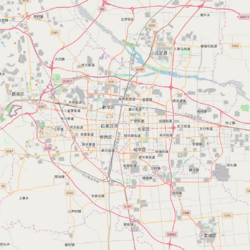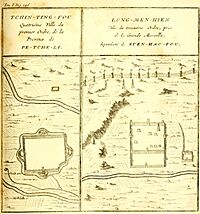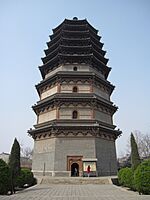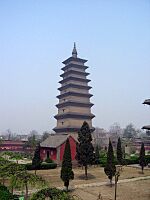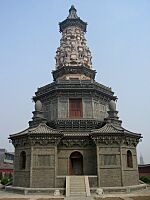Zhengding County facts for kids
Quick facts for kids
Zhengding County
正定县
|
|
|---|---|
|
County
|
|
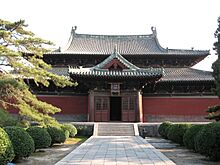
The Manichaean Hall of the Longxing Monastery
|
|
| Country | People's Republic of China |
| Province | Hebei |
| Prefecture-level city | Shijiazhuang |
| Area | |
| • Total | 468 km2 (181 sq mi) |
| Population | |
| • Total | 594,000 |
| • Density | 1,269.2/km2 (3,287/sq mi) |
| Time zone | UTC+8 (China Standard) |
Zhengding (Chinese: 正定县), once called Zhending, is a county in Hebei Province, China. It's located about 260 kilometers (160 miles) south of Beijing, the capital of China. Zhengding is part of the city of Shijiazhuang, which is the capital of Hebei Province. About 594,000 people live here.
For over 1,000 years, Zhengding has been a very important religious place. Many major schools of Chan Buddhism started here. Sadly, many old religious buildings have been damaged over time. However, the Longxing Monastery is still mostly intact. Also, four famous pagodas, each with its own unique design, are still standing tall.
Contents
A Look Back: Zhengding's History
People have lived in the Zhengding area since the early Neolithic Period, which was a very long time ago. During the Spring and Autumn period, a kingdom called Xianyu had its capital here.
Later, under the Han dynasty, this area was known as Dongyuan. An emperor named Liu Bang even led a battle here around 190 BC. In 256 AD, during the Western Jin dynasty, a new area called Changshan Prefecture was set up in the county.
In 923, during a time known as the Five Dynasties and Ten Kingdoms, the area was renamed Zhengding Prefecture. It was later divided into Zhengding Prefecture and Zhongshan County. Zhengding County as we know it today was created in 1723 during the Qing dynasty. In 1949, it became part of Shijiazhuang Prefecture, and in 1986, it officially joined the city of Shijiazhuang.
An important person in China's history, Xi Jinping, who is now the President, worked in Zhengding. He was in charge of the county's Party Committee from 1983 to 1985. He asked to work in this rural area. He is known for having a traditional Qing dynasty-style mansion built here. This mansion was used for filming the TV series Dream of Red Mansions.
Zhengding's Geography and Climate
Zhengding County is located at an elevation between 57.6 and 105.2 meters (189 to 345 feet). It has a monsoon climate, which means it has four clear seasons.
On average, the temperature is 13.6°C (56.5°F) throughout the year. The air is usually about 62% humid. Zhengding gets about 474.4 mm (18.7 inches) of rain each year and enjoys 2,736 hours of sunshine. The period without frost lasts for more than 200 days every year, which is good for farming.
Local Areas: Administrative Divisions
As of 2020, Zhengding County is divided into different areas for local government. It has 2 subdistricts, 4 towns, and 3 townships. These areas then manage 174 villages and 186 natural villages.
- Subdistricts: Zhufutun, Sanlitun
- Towns: Zhengding Town, Xin'an, Xinchengpu, Nangang, Quyangqiao Town
- Townships: Xipingle Township, Nanniu Township, Nanlou Township
Amazing Pagodas of Zhengding
Zhengding is famous for its four ancient pagodas, each with a unique history and style.
| Name | Construction | Height | Number of storeys | Floor plan | First built | Present form dates from |
|---|---|---|---|---|---|---|
| Chengling Pagoda | brick | 33 m | 9 | octagon | Eastern Wei dynasty (540) | Jin dynasty (1161–1189) |
| Lingxiao Pagoda | wood and brick | 41 m | 9 | octagon | Tang dynasty, (762–779) | Song dynasty (1045) |
| Xumi Pagoda | stone and brick | 48 m | 13 outside, 2 inside | square | Tang dynasty, (636) | Tang dynasty |
| Hua Pagoda | brick | 40 m | 4 | octagon, circle | Tang dynasty | Jin dynasty |
Chengling Pagoda: The Grey Pagoda
The Chengling Pagoda is built from gray bricks, which is why it's also called the Grey Pagoda. It's located in Linji Village, south of Zhengding. It used to be part of the Linji Temple, which was built in 540 during the Eastern Wei dynasty.
During the Tang dynasty, a monk named Linji Yixuan started the Linji School of Buddhism here. Both the monk and the school got their names from the village. The pagoda was first built in 867 to honor Linji Yixuan. The original pagoda was later replaced by the current one between 1161 and 1189, during the Jin dynasty.
This pagoda stands on a special base called a Sumeru Pedestal, named after the mythical Mount Sumeru. It has nine levels and is 33 meters (108 feet) tall. Its base is beautifully decorated. Because it's seen as one of the starting places of Zen Buddhism, the Chengling Pagoda is a popular spot for visitors, especially from Japan.
Lingxiao Pagoda: The Wooden Pagoda
The Lingxiao Pagoda, also known as the Wooden Pagoda, is made of both wood and bricks. It was once part of the Tianning Monastery. It was first built in 860 during the Tang dynasty and has been repaired many times since then. The way it looks today was designed in 1045 during the Song dynasty, and this style has been kept in later repairs.
The pagoda has an octagonal (eight-sided) shape, nine levels, and is 41 meters (135 feet) tall. The bottom four levels are made of bricks with wooden eaves. From the fifth level up, the pagoda is entirely made of wood, built around a central pillar. The levels get shorter as you go up, especially in the top five wooden levels. At the very top, there's a cast iron spire.
This pagoda is also a place of historical significance. In 1937, a Dutch bishop, Mgr. Frans Schraven, and his companions were protecting Chinese women and girls who had sought safety in their compound. They refused to hand them over to soldiers and faced a difficult situation at the foot of this pagoda.
Xumi Pagoda: The Tallest Pagoda
The Xumi Pagoda, named after the mythical Mount Sumeru, is sometimes called the Summer Pagoda. It's part of the Kaiyuan Monastery, located west of Zhengding. Built from stone and bricks, it is the tallest pagoda in Zhengding, standing 48 meters (157 feet) high.
The pagoda has a simple, strong design with a square shape, sitting on a square stone platform. The lower part of the first level also uses stones. The Xumi Pagoda was built in 636 during the Tang dynasty. Inside, the pagoda is mostly empty and doesn't have a staircase, except for a wooden ceiling over the first level (which no longer has floorboards).
The outside of the pagoda has simple decorations, including thirteen layers of eaves and stone carvings of the Heavenly Kings at the corners of the stone platform. The Kaiyuan Monastery originally had four main buildings: Tianwang Hall, Fachuan Hall (now in ruins), a bell tower, and this pagoda. Today, most of the Monastery is gone, and the Xumi Pagoda stands surrounded by trees.
Hua Pagoda: The Flower Pagoda
The Hua Pagoda, also known as the Flower Pagoda, is part of Guanghui Temple in southern Zhengding. It's a four-level brick building with an unusual shape, about 40 meters (131 feet) tall. The bottom three levels are octagonal (eight-sided), but the fourth level is circular. Its walls narrow towards the top, making it look like a cone.
This top level is richly decorated with carvings of Buddhas, elephants, and water animals. Another special feature of the Hua Pagoda is its four small attached buildings, which are pagodas themselves. These small pagodas are topped with an egg-shaped tip. They were lost for a while but have recently been fully restored. The Hua Pagoda was first built during the Tang dynasty, and its current structure dates back to a rebuilding during the Jin dynasty.
Other Historical Discoveries
In June 2000, a huge stone turtle called a bixi was found in Zhengding. This stone turtle was originally meant to hold up a giant stone tablet. It is 8.4 meters (27.6 feet) long, 3.2 meters (10.5 feet) wide, and 2.6 meters (8.5 feet) tall, weighing a massive 107 tons! Experts believe it is about 1200 years old. It has since been moved to Kaiyuan Temple.
Getting Around: Transportation
Zhengding has important connections for trains and roads. Major railways like the Beijing–Guangzhou, Shijiazhuang–Taiyuan, and Shijiazhuang–Dezhou lines pass through here.
Important expressways also serve the area, including the Beijing–Hong Kong and Macau and Qingdao–Yinchuan Expressways.
Line 1 of the Shijiazhuang Metro has four stations in Zhengding County, making it easy to travel within the area.
The Shijiazhuang Zhengding International Airport (SJW/ZBSJ) is located in the northeast part of the county. The Zhengding Airport railway station, which is on the new Beijing–Guangzhou–Shenzhen–Hong Kong High-Speed Railway, is also nearby.



